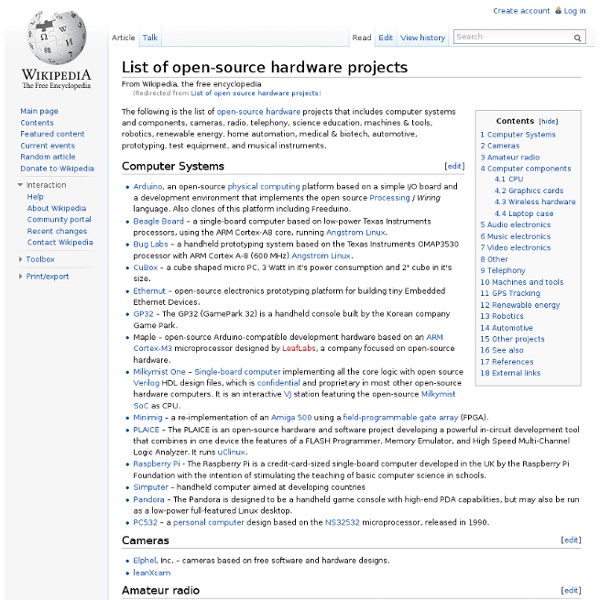Dangerous Prototypes | A new open source hardware project every month
Wine (software)
Wine is a free and open source software application that aims to allow applications designed for Microsoft Windows to run on Unix-like operating systems. Wine also provides a software library, known as Winelib, against which developers can compile Windows applications to help port them to Unix-like systems.[3] The name Wine initially was an acronym for windows emulator.[7] Its meaning later shifted to the recursive backronym, wine is not an emulator in order to differentiate the software from CPU emulators.[8] While the name sometimes appears in the forms WINE and wine, the project developers have agreed to standardize on the form Wine.[9] The phrase "wine is not an emulator" is a reference to the fact that no processor code execution emulation occurs when running a Windows application under Wine. Wine officially entered beta with version 0.9 on 25 October 2005.[18] Version 1.0 was released on 17 June 2008,[19] after 15 years of development. Software that runs flawlessly ("Platinum")
DIY Book Scanning | A forum dedicated to book scanning, open source, DIY digitization.
WyoLum Emergents - Open Source Electronics for Huge Nerds
Ubuntu (operating system)
Development of Ubuntu is led by Canonical Ltd.,[11] a company based on the Isle of Man and owned by South African entrepreneur Mark Shuttleworth. Canonical generates revenue through the sale of technical support and other services related to Ubuntu.[12][13] The Ubuntu project is publicly committed to the principles of open source development; people are encouraged to use free software, study how it works, improve upon it, and distribute it.[14][15] GNOME (the former default desktop) supports more than 46 languages.[17] For increased security, the sudo tool is used to assign temporary privileges for performing administrative tasks, allowing the root account to remain locked, and preventing inexperienced users from inadvertently making catastrophic system changes or opening security holes.[18] PolicyKit is also being widely implemented into the desktop to further harden the system through the principle of least privilege. Ubuntu is currently funded by Canonical Ltd.
Welcome - Fritzing
WineHQ - Run Windows applications on Linux, BSD, Solaris and Mac OS X
DoD Open Research System (ORS) - Getting An Account
Step 1: Get a pIE Account Before you can gain access to the HPC systems at any of the DSRCs, you must first get an account on the Portal to the Information Environment (commonly referred to as a pIE account). If you do not yet have a pIE account, you can request one by following the instructions found at the CCAC Accounts Center . Step 2: HPCMP.HPC.MIL Kerberos Realm Account Holders If you currently have an HPCMP.HPC.MIL Kerberos Realm account proceed to step 3. All others If you do NOT have an HPCMP.HPC.MIL Kerberos Realm account, and you only need access to the Open Research Systems, and you have requested an ARSC.EDU (or after October 1, ORS.HPC.MIL) Realm account, you must complete the following instructions: User vetting Process US Citizens must provide copies of one of the following: Passport Naturalization Certificate Birth Certificate US Passport Card Foreign Nationals must provide copies of the following: Copies of these documents may be either faxed or e-mailed to:
Available Hardware By DoD Supercomputing Resource Centers
* DefinitionsHPC - High Performance ComputerTDS - Test Development SystemSciVis - Scientific VisualizationAverage Capability - Size dependent, average benchmark capability: The number of Habu-equivalents represented by the entire system. Back to Top
Who we are | T2K Open Supercomputer
Why Allied? – aim of the alliance The T2K Open Supercomputer Alliance was established primarily aiming at collaborative work on the specification design for new supercomputers procured by the following three member universities. Center for Computational Sciences, University of TsukubaInformation Technology Center, University of TokyoAcademic Center for Computing and Media Studies, Kyoto University This activity is for creative procurements at the initiative of universities based on technology market research, rather than those by choosing machines from product market and at the initiative of system venders. What Going on?
Arduino | Proyecto Arduino
Presentación de Proyecto Arduino para Técnicas En el día de ayer se llevó a cabo la presentación oficial del proyecto Arduino en la Escuela Técnica Nº 25. Estuvo presente el Sr. Pablo Sánchez, Director de Educación Técnica de la Ciudad, y asistieron docentes y directivos de escuelas de esa modalidad. Durante el encuentro se proyectó una presentación, donde se explicó qué es Arduino, las características de la placa, la estructura del entorno de programación, y las diferencias respecto de otros microcontroladores. La coordinadora de la Red de Escuelas , Silvina Casella, junto a Pablo Sánchez, contaron cuál es la proyección para el año 2009, y también hubo un espacio para el intercambio, con preguntas y comentarios de los asistentes a la presentación. Sobre el final, varios docentes se acercaron a observar el funcionamiento de la placa con algunos ejercicios que habíamos preparado. Les dejamos también la presentación que preparamos para el evento. Primera Exposición de Escuelas Técnicas



